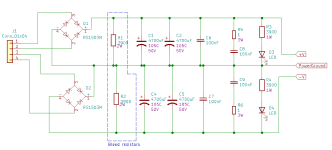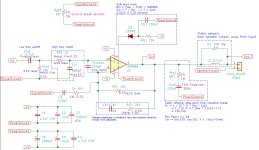Hi,
The Serj Amp 1 project I did a few years ago has been working fine (besides a hum, so maybe ground loop), and continues to do so.
I was looking into setting up a test PSU for my next project, and noticed there is some 84V DC offset relative to safety earth (the Earth pin on the UK plug).
I just tried instrumenting my Serj Amp 1 (which has been working fine) and that also has the same, IF and only if I unplug my LM3886 boards from the power / or if I unplug the audio input internal connections.
As far as I can see, doing either of those (unplugging my molex for the power / unplugging JST for audio) disconnects the ground conductor that appears to be pulling the PSU ground to 0v (w.r.t. safety earth).
I have to get some pictures of the board setup (to post on this thread), but it seems like PowerGround net is being pulled to safety earth via the Rgb1 resistor so that the SignalGround is connected.
SignalGround may be making a connection to the metal case (which IS tied to Safety Earth) via the RCA connectors (they do have nylon insulators, but might be making contact).
Rather than leaving PowerGround floating, what's the appropriate UK-specific advice on equalising the potential difference between my device and my PC that's connected to it?
Surely my PC's audio line out is earthed to safety earth, and having this 84V would cause a current draw and power consumption?
Thank you in advance 🙂
The Serj Amp 1 project I did a few years ago has been working fine (besides a hum, so maybe ground loop), and continues to do so.
I was looking into setting up a test PSU for my next project, and noticed there is some 84V DC offset relative to safety earth (the Earth pin on the UK plug).
I just tried instrumenting my Serj Amp 1 (which has been working fine) and that also has the same, IF and only if I unplug my LM3886 boards from the power / or if I unplug the audio input internal connections.
As far as I can see, doing either of those (unplugging my molex for the power / unplugging JST for audio) disconnects the ground conductor that appears to be pulling the PSU ground to 0v (w.r.t. safety earth).
I have to get some pictures of the board setup (to post on this thread), but it seems like PowerGround net is being pulled to safety earth via the Rgb1 resistor so that the SignalGround is connected.
SignalGround may be making a connection to the metal case (which IS tied to Safety Earth) via the RCA connectors (they do have nylon insulators, but might be making contact).
Rather than leaving PowerGround floating, what's the appropriate UK-specific advice on equalising the potential difference between my device and my PC that's connected to it?
Surely my PC's audio line out is earthed to safety earth, and having this 84V would cause a current draw and power consumption?
Thank you in advance 🙂
Attachments
Yes it is normal with floating Audio GND. You need to reference Audio GND of the common point in the PSU to PE with a 10 ..100 Ohm 2W resistor that is all. It is caused by leakage. In light devices one can even use 1 kOhm and still have result.
You will notice both + (yes also there AC) and Audio GND will not have any AC component anymore.
PE = primary side of PSU. Primarily for safety. Always directly connected to metal casings in DIY stuff.
(Audio) GND = secondary side of PSU, common point in symmetric PSUs.
You will notice both + (yes also there AC) and Audio GND will not have any AC component anymore.
PE = primary side of PSU. Primarily for safety. Always directly connected to metal casings in DIY stuff.
(Audio) GND = secondary side of PSU, common point in symmetric PSUs.
Last edited:
Each audio board (2 boards, it's a 2.0 stereo system) has a 1 ohm resistor (can't remember the wattage of it offhand) that joins the input audio GND with PE.
When you say "leakage", do you also imply there's very little current flowing between PSU ground and Safety Earth?
The reason I was looking into this was that I was about to connect my oscilloscope to my new project's PSU GND and remembered that the scope's GND connector is directly connected to Safety Earth - so a 84V potential would cause current to flow and blow up the scope's probe.
When you say "leakage", do you also imply there's very little current flowing between PSU ground and Safety Earth?
The reason I was looking into this was that I was about to connect my oscilloscope to my new project's PSU GND and remembered that the scope's GND connector is directly connected to Safety Earth - so a 84V potential would cause current to flow and blow up the scope's probe.
You are right about the latter when using the scopes GND randomly in a circuit 🙂 Standard operating error. Please call it PE and not ground, earth and such as terms have the same meaning in english.
It is normally leakage and very low current and therefor solved with small value resistors. The voltage it creates may be destructive though for semis. Have to go now, ciao!
It is normally leakage and very low current and therefor solved with small value resistors. The voltage it creates may be destructive though for semis. Have to go now, ciao!
AC of half mains is common from a high impedance.
A big DC offset is a bit more unusual, possible in some smps with a little board leakage from the rectified mains
A big DC offset is a bit more unusual, possible in some smps with a little board leakage from the rectified mains
Why would that also not apply to:You are right about the latter. Standard operating error. Please call it PE and not ground, earth and such as terms have the same meaning in english.
It is normally very low current and therefor solved with small value resistors. Have to go now, ciao!
Computer's Line Out ground shield ==> my amp's SignalGround? If SignalGround was also +84V respect to SafetyEarth?
Shouldn't they all be 0v w.r.t. SafetyEarth?
I have trouble understanding the used terminology, sorry. And I really have to go.
Post 2, first line.
Post 2, first line.
AC of half mains is common from a high impedance.
A big DC offset is a bit more unusual, possible in some smps with a little board leakage from the rectified mains
Right. My mistake. It is actually 84V AC. 0v DC.
That's measured between the PowerGround netlabel in my schematic and the safety earth.
That sounds like it's ok?
What would cause the high impedance besides the toroid transformer?
I have trouble understanding the used terminology, sorry. And I really have to go.
Post 2, first line.
Yes it is normal with floating Audio GND. You need to reference Audio GND of the common point in the PSU to PE with a 10 ..100 Ohm 2W resistor that is all. It is caused by leakage. In light devices one can even use 1 kOhm and still have result.
Yes, however is it actually ok to have Audio GND connected to PE, given that they are 2 devices with 2 different power supplies that appear to be floating with respect to each other? Audio GND coming from the computer, which has its own PSU, and PE being from my amp which has a different PSU, and their 0V points might not be exactly the same potential with respect to safety earth. You said I can use a small resistor, but, if the potential difference is large, would that cause a massive current between the 2 devices?
Audio GND is not called GND or 0 without reason. However due to leakage of transformer and other coupling mechanisms a tiny leakage current may occur leading to voltage buildup at both +, - and GND when they are floating. Thanks to Georg Ohm: https://www.britannica.com/biography/Georg-Ohm
This tiny current can be "shorted" to PE. Of 1 channel, of 2 channels, of 3 even but give each device that resistor. There will be not be a noteworthy current. The voltage buildup seems large but it drops to 0V even with 1 kOhm. 100 Ohm is better in power amplifiers with larger transformers.
This voltage buildup is cause of defects with for instance HDMI chips. The current is very low but the voltage kills sensitive ICs.
Direct coupling of Audio GND to PE is a no no in good audio (but normal procedure in the UK). Reward is eternal hum.
This tiny current can be "shorted" to PE. Of 1 channel, of 2 channels, of 3 even but give each device that resistor. There will be not be a noteworthy current. The voltage buildup seems large but it drops to 0V even with 1 kOhm. 100 Ohm is better in power amplifiers with larger transformers.
This voltage buildup is cause of defects with for instance HDMI chips. The current is very low but the voltage kills sensitive ICs.
Direct coupling of Audio GND to PE is a no no in good audio (but normal procedure in the UK). Reward is eternal hum.
Last edited:
Distributed capacitance between primary and secondary and any class Y capacitors L-PE and N-PE both lead to half mains appearing between the output "GND" and PE from an impedance of the reactance of these capacitors - why class Y is limited in value to single nF levels.
Grounding everything to a common bonded and meshed ground is the EMC way these RF saturated days. Anything very sensitive should be balanced to avoid hum.
Grounding everything to a common bonded and meshed ground is the EMC way these RF saturated days. Anything very sensitive should be balanced to avoid hum.
- Home
- Amplifiers
- Power Supplies
- PSU ground is some 84V DC above Safety Earth - is this normal?

